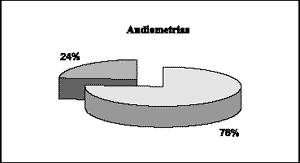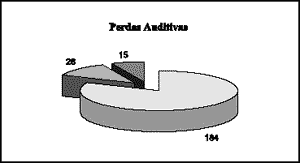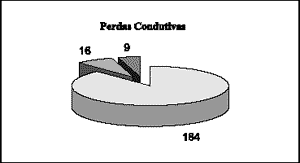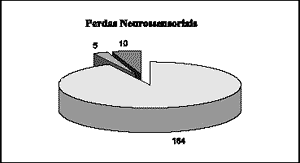INTRODUCTIONHearing loss may result to innumerous impairments that interfere in linguist, educational and psychosocial development of children. Thus, hearing assessment at school-age children is necessary to early detect and correct auditory affections.
Sensorial hearing deprivation in the first years of life causes delay in acquisition and language development that affects social, psychological and educational development of the child and that is the reason why hearing impairment has to be detected as soon as possible.
Middle ear affections in children are normally responsible for the great incidence of auditory compromise leading to conductive hearing loss, which results in secretory otitis media, as reported by Grimes1 (1985).
Congenital rubella is a significant etiological factor of hearing loss with predominance of profound or moderate symmetrical sensorineural hearing loss, and the pathology is normally diagnosed at early age so that hearing aid fitting can be performed [Azevedo et al2 (1989)].
Normal hearing is essential for language development, which favors social interaction and acquisition of knowledge, in addition to transmitting thoughts and feelings; thus, diagnosis of hearing loss should be performed as early as possible, as reported by Abe & Stamm3 (1991) and Costa et al4 (1991).
Hearing loss may be caused by different etiologies such as genetic and environmental factors. The marked predominance of environmental etiologies reflects the medical-sanitary conditions of our population, whose improvement depends on prophylaxis of hearing loss, as stated by Simões & Maciel-Guerra5 (1992).
Children with hearing loss should have type of hearing loss, severity and identification of etiology assessed so that the rehabilitation can be planned. There are two types of hearing losses: conductive and sensorineural. Conductive hearing loss is caused by otitis media, with mild to moderate loss, or middle and/or external ear malformations, causing moderate to severe loss. Sensorineural loss may have a series of etiologies, such as heritage, perinatal factors, rubella, meningitis, ototoxicity, acquired causes, etc., as discussed by Todd6 (1994).
Acquired hearing loss may be related to pollution, especially industrial pollution, caused by heavy metals such as lead, as suggested by Osman et al7 (1999).
As to chronic otitis media, the prevention of severe complications is essential and early diagnosis and surgical treatment are paramount, as reported by Vartiainen8 (1998).
The prevalence of hearing loss in school-age children doubles when children who have minimal sensorineural hearing loss are included; according to Bess et al9 (1998), these children have difficulty to progress at school and present significant educational disadvantage.
The present study aimed at identifying and quantifying the most frequent audiometric abnormalities in children from public schools.
Material and MethodAfter the approval by the ethics committee on research, we conducted the present study at the ambulatory of Otorhinolaryngology, Hospital das Clínicas, Medical School, Federal University of Goiás, in November 1998.
We assessed 121 school-age children from elementary and primary schools of the city of Goiania, aged 7 to 14 years. The children were assessed by Otorhinolaryngologists with complete ENT examination, anamnesis, otoscopy, pure tone audiometry and immittance measures. If necessary, earwax was removed before the performance of the audiometry tests.
Hearing losses were flat and we considered normal thresholds up to 15dB and mild loss up to 25 dB.
RESULTSWe assessed 121 children, totaling 242 ears and we found that: 184 (76%) ears had audiometry within normal ranges, and 58 (24%) had abnormal audiometry (Graph 1).
The most frequent audiometric abnormalities were: mild conductive hearing loss in 26 (12%) ears, being 16 (8%) on the left and 9 (4%) on the right; mild sensorineural hearing loss in 15 (7%) ears, being 5 (2%) on the left and 10 (5%) on the right (Graphs 2, 3 and 4).
Immittance measures were made in 242 ears and the results were: tympanometry type A in 230 (94%) ears, type B in 6 (3%) and type C in 6 (3%). Acoustic reflexes were present in 236 ears (97%) and absent in 6 (3%) (Graph 3).
Otoscopy showed compatible presentation of secretory otitis media, with middle ear effusion and blisters in 6 ears (3%). There were no tympanic membrane perforations or retractions and the remaining tympanic membranes were equally intact.

Graph 1. Graph of normal 76% and abnormal 24% audiometries.

Graph 2. Graph demonstrating normal audiometry, 184 ears; conductive hearing loss, 26 ears, and mild sensorineural hearing loss, 15 ears.

Graph 3. Abnormal tympanometry, being Type “A” curve, 94%, Type “B,” 3% and Type “C”, 3%.

Graph 4. Conductive hearing loss: left ears, 16 and right ears, 9.

Graph 5. Mild sensorineural hearing loss on left ears, 5 and on right ears, 10.
The auditory disorders in the school age range should be early identified and corrected because hearing impairment interferes in the linguist, educational and psychosocial development of the child, as reported by Abe & Stamm (1991) and Costa et al (1991).
We identified the incidence of conductive hearing loss as a result of secretory otitis media in evolution or involution, related to presence of type B tympanometric curve in cases of evolution and type C in cases of involution that still presented auditory tube dysfunction, as observed by Grimes (1985).
We would like to emphasize the importance of investigating etiology of sensorineural hearing loss in an attempt to identify congenital rubella, genetic causes, environmental factors, industrial pollution and chronic otitis media, as mentioned by Grimes (1985), Azevedo et al (1989), Simões & Maciel-Guerra (1992), Todd (1994), Vartiainen (1998) and Osman et al (1999).
It is fundamental to perform early detection and rehabilitation of children with hearing loss at this age range, as reported by Todd (1994).
The incidence of conductive and mild sensorineural hearing loss in school-age children is related to poor educational achievement of these children, agreeing with Bess et al (1998).
CONCLUSIONSThe analysis of our results led us to conclude that the incidence of mild hearing loss is significant in school-age children, and conductive loss is more frequent than sensorineural in the studied group, leading to compromise of hearing and attention, requiring early diagnosis and treatment to improve educational performance.
REFERENCES1. Grimes CT. Audiologic Evaluation in Infancy and Childhood. Pediatric Annals 1985;14:211-9.
2. Azevedo MF, Vilanova LCP, Carvalho RMM, Garcia VL, Fujinami AA. Rubéola congênita: caracterização dos aspectos clínicos e audiológicos. Acta Awho 1989;8:97-104.
3. Abe LMO, Stamm DG. Detecção Precoce da Deficiência Auditiva. Ars Cvrandi – A revista do clínico geral 1991;37-43.
4. Costa EA, Ferreira RPI, Mari AR. Da necessidade de se identificar a deficiência auditiva na criança o mais cedo possível. Jornal de Pediatria 1991;67:137-41.
5. Simões AM, Maciel-Guerra AT. A surdez evitável: predominância de fatores ambientais na etiologia da surdez neurossensorial profunda. Jornal de Pediatria 1992;68:254-57.
6. Todd NW. At-risk populations for hearing impairment in infants and young children. International Journal of Pediatric Otorhinolaryngology 1994;29:11-21.
7. Osman K, Pawlas K; Schutz A, Gazdzik M, Sokal JA, Vahter M. Lead exposure and hearing effects in children in Katowice, Poland. Environ Research Section 1999;80:1-8.
8. Vartiainen E. Changes in the clinical presentation of chronic otitis media from the 1970s to the 1990s. The Journal of Laryngology and Otology 1998;112:1030-37.
9. Bess FH, Dodd-Murphy J, Parker RA. Children with minimal sensorineural hearing loss: prevalence, educational performance, and functional status. Ear & Hearing 1998;19:339-54.
1 Master in Otorhinolaryngology, Medical School of Ribeirão Preto, University of São Paulo, Doctorate studied in Otorhinolaryngology under course, Medical School, University of São Paulo.
2 Master studies in Otorhinolaryngology under course, Medical School of Ribeirão Preto, University of São Paulo.
3 Preceptor of medical residence, Medical School, Federal University of Goiás.
4 Resident physician in Otorhinolaryngology, Medical School, Federal University of Goiás.
Affiliation: Medical School, Federal University of Goiás.
Address correspondence to: Simone Adad Araújo – Rua 20, nº 324, apto 201, Setor Central, Goiânia/Goiás CEP 74030-110 - Tel (55 62) 224.2282
Presented at 35º Congresso Brasileiro de Otorrinolaringologia and 9º Congresso Iberolatinoamericano de Otorrinolaringologia.
Article submitted on November 01, 2001. Article accepted on December 20, 2001.


